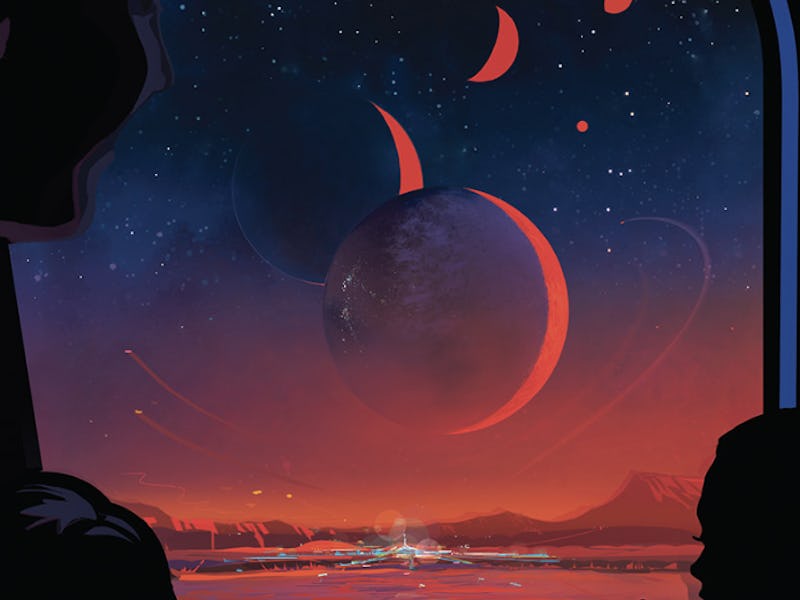The Artsy Weirdos Behind NASA's Retro Space Travel Campaign
Picture booking a trip with the Exoplanet Travel Bureau.

Imagine you’re on spring break — except instead of on a crowded, sweaty Mexican beach, you’re 40 light-years away, on TRAPPIST-1e, one of seven Earth-size planets that orbit around the dwarf star TRAPPIST-1. When you look up towards the red sky, you see six objects, like seeing a sextet of moons.
That future vacation scene is what the artists at NASA’s Jet Propulsion Laboratory spend their days envisioning in a recent poster series titled Visions of the Future. Each of the 14 posters melds vintage airline poster art with a space travel twist, imagining what interstellar travel to a far-flung planet might be like.
“These posters are essentially imagination layered on top of plausible, scientific reality,” David Delgado, a visual strategist at NASA’s Jet Propulsion Lab, tells Inverse. “The idea is that we are presenting a desirable future.”
Delgado is part of a collaborative team of artists and designers called The Studio, a creative studio located in California that is part of the JPL. NASA approached Delgado and his team to create a product that ignited the imagination in an approachable way.
"Some 40 light-years from Earth, a planet called TRAPPIST-1e offers a heart-stopping view."
Designing travel posters seemed a natural fit. The team worked with the JPL to determine the most scientifically accurate yet interesting aspects of these exoplanets, then used those facts to anchor the piece.
"Kepler-186f is the first Earth-size planet discovered in the potentially 'habitable zone.'"
“Forty percent of creating these posters was spending the time researching and talking with scientists to make sure that we had all of the details right,” Delgado says. “It is a balance because while we wanted to be accurate, these places are also not totally figured out. Even with some of the newly discovered ones, like TRAPPIST-e, the biggest information that’s been verified is just the number of planets and their proximity to their parent star.”
"PSO J318.5-22 belongs to a special class of planets called rogue, or free-floating, planets."
And while the posters are probably the most viral products the JPL has been able to move the story of exoplanets from NASA nerd circles to pop culture, The Studio is pushing space storytelling forward in other ways. One is what Delgado terms “sneaking up on learning,” where art and design are used to enrich and expand the central concept of a mission or scientific question. An example is a visual and audio installation the team created called “Orbit”, a dome filled with 28 speakers that triggers speakers to emit sounds when NASA’s Earth science satellites pass overhead, ranging from tree branches moving to frogs croaking to even human voices. The idea is to make the constant overhead traffic of satellites and the data they are collecting more present for Earthlings.
Overhead "Orbit."
The Studio has been most instrumental in helping JPL transcend science and “sell the story” of missions, bridging accuracy with imagination. Delgado says that focusing on big questions that drive both science and researchers are integral to developing a compelling poster.
“One of the greatest things I love about working at a scientific institution is that people love what they are doing,” Delgado says. “The excitement is contagious. We try to do what we can to bring that excitement out and share it with others.”